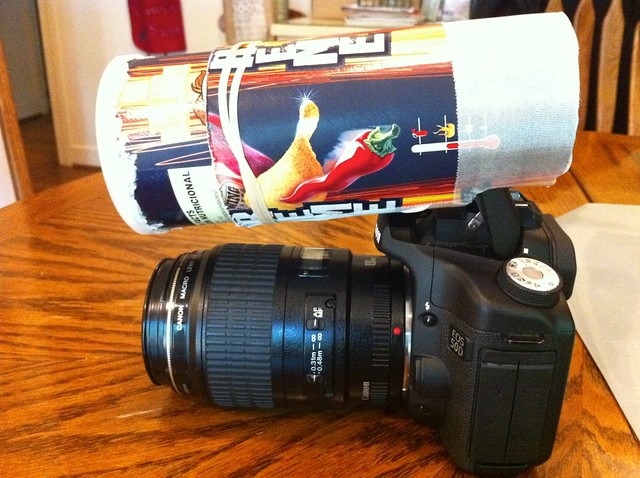A while ago I stumbled upon a website new to me called DIYPhotography.net, and it’s been loads of fun to see what kind of clever contraptions people come up with for their photo projects. The one that caught my eye initially was this article; “Super Easy Macro Light Using a Pringles Can”. I’ve been wanting to try it out, and finally this weekend I got around to it. I don’t own a Canon dSLR with a pop-up flash, so I borrowed dad’s and went to work. I documented the process as well, so here we go!
1. Select a Pringles can
While it doesn’t matter which flavor you buy, you may as well get one you’ll enjoy. It’s nice to know that after a few handfuls of these, I’ve fulfilled my sodium intake for the week. Yum. Also I hadn’t realized until later that the lid on my Pringles can was clear, which is actually very cool. As you’ll see, it made it dead easy to add a diffusion layer to the can. When shopping, look for the clear lid. Maybe they all have that now… I’m no Pringles Expert.
2. Cut a hole for the flash
In these photos that follow, notice that I cut the bottom off the can first, which I then realized to make this as effective as possible, I’d have to cover the hole back up. I eventually taped the cut-off bottom back onto it. Of course I ultimately realized that it was totally unnecessary to take the bottom off in the first place—if you just cut a hole for the pop-up flash, then your work is done. If however you want to put this on a larger flash head, then cutting off the bottom is necessary. And it’ll fit perfectly over Canon 580 flash as well.
 The box is roughly the shape of the flash, and was my initial guide to cutting a hole. However if you only plan on using this on a pop-up flash, there’s no need to cut the bottom of the can off initially.
The box is roughly the shape of the flash, and was my initial guide to cutting a hole. However if you only plan on using this on a pop-up flash, there’s no need to cut the bottom of the can off initially.
 Cutting out the hole. Watch those fingers!
Cutting out the hole. Watch those fingers!
 You can see the flash popping through the hole here. Again, if I hadn’t taken the bottom off the can initially, that would have been more clever.
You can see the flash popping through the hole here. Again, if I hadn’t taken the bottom off the can initially, that would have been more clever.
3. Cover the ends
Again there’s no need to remove the bottom unless you’ll be attaching this to a big flash. Here I’ve taped the bottom back onto mine. On the business end of this gadget, I simply layered a piece of tissue over the tube and snapped the clear lid back on, then tore off the edges of the tissue. You could add more layers to this, or even add a color gel if you wanted to. You could also build cones, or a lid with holes in it… really, the options are endless.
 The back end taped back on, and now attached to the flash. If you cut the hole just the right size, the can will hold itself on the camera. Nice!
The back end taped back on, and now attached to the flash. If you cut the hole just the right size, the can will hold itself on the camera. Nice!
 A plain ol’ tissue is between the can and the lid here. You could add multiple layers to reduce the light output if you wanted to—definitely necessary if you put this on the end of a big flash. You could add gels, cut holes in a lid, really do anything here.
A plain ol’ tissue is between the can and the lid here. You could add multiple layers to reduce the light output if you wanted to—definitely necessary if you put this on the end of a big flash. You could add gels, cut holes in a lid, really do anything here.
 The excess tissue has been torn away. Real classy looking, huh?
The excess tissue has been torn away. Real classy looking, huh?
4. The telescoping tube
I realized right away that the full length of the tube was too long, and initially I was just going to trim it, but then I thought it’d be more useful if it was adjustable. So, I cut the can in half and slit the back half up the middle so the first half could slide inside. With a little creative taping and a rubber band for tension, the whole thing holds together beautifully.
 Here’s the can cut in half. Next step was to slit the back half down the middle, from the flash-hole forward.
Here’s the can cut in half. Next step was to slit the back half down the middle, from the flash-hole forward.
 The front half is now inserted into the back half. You can see the split up the back half of the can. Next step was to tape it up.
The front half is now inserted into the back half. You can see the split up the back half of the can. Next step was to tape it up.
 All taped up and ready to go. The rubber band adds a little tension to the tube, keeping it from sliding in and out unexpectedly.
All taped up and ready to go. The rubber band adds a little tension to the tube, keeping it from sliding in and out unexpectedly.
5. The finished product
As you can see, the can is self-supporting, and the telescoping tube allows you to position the light source closer to your subject, or pull it back if you’re shooting something super close to the lens. Also I don’t see why you couldn’t extend this even longer, using an extra Pringles can, if you wanted to shoot from farther away but have the light “source” (that’s now the end of the tube, as far as the subject is concerned) closer to a distant subject. You’d need to support it somehow, though, for sure.
 The telescoping Pringles macro light extended all the way, for a more distant subject.
The telescoping Pringles macro light extended all the way, for a more distant subject.
 The telescoping Pringles macro light collapsed for a closer subject.
The telescoping Pringles macro light collapsed for a closer subject.
6. The results!
Let’s see the results! Three photos here; the first is the reference photo. Indoors, no flash. Same light on the background as on the flower, and also a very long exposure—impossible to hand-hold. Booooooring.
The second photo is the on-camera flash with no modification. Which I have to admit I’m actually surprised it was that good, but notice the hard shadows and also notice how lit the background is.
The third photo is using the Pringles can. Notice that the shadows on the flower are much softer, a result of a larger and closer light source. Also notice that the background is darker, because there wasn’t as much spill from the light, which was directed and focused on the flower.
 Ambient light only (reference shot). ISO 400, 0.4s ƒ9.0 (that’s nearly half a second, so impossible to hand-hold)
Ambient light only (reference shot). ISO 400, 0.4s ƒ9.0 (that’s nearly half a second, so impossible to hand-hold)
 Unmodified pop-up flash. 1/200th second at ƒ/4. Notice the hard shadows and brightly-lit background (spill from the flash, not ambient light at that shutter speed)
Unmodified pop-up flash. 1/200th second at ƒ/4. Notice the hard shadows and brightly-lit background (spill from the flash, not ambient light at that shutter speed)
 Pringles can modified light source. Same exposure as above; 1/200 at ƒ/4. Notice both the softer shadows and the darker background; due to less light spilling past the flower.
Pringles can modified light source. Same exposure as above; 1/200 at ƒ/4. Notice both the softer shadows and the darker background; due to less light spilling past the flower.
Remember, to get soft, wrap-around light, you want the biggest light source possible. But size is relative. To the flower, the light source in the second photo (unmodified pop-up flash) is nearly two feet away and the size of a pinky finger. Include the distance in the calculation, and it’s a tiny tiny source. In this third photo however, the “source” is actually the end of the Pringles can, so it’s much closer (about 8 inches or so away), and the source is as big as the flower itself—the end of the can. Huge difference.
Conclusion?
So what have we learned from all this? That DIY stuff is fun, and a great way to blow an hour of a holiday weekend! Seriously, I think this is a fantastic modification, all for the cost of a bag tube of chips. If you have a pop-up flash and a close-up lens, you could do a lot worse than this.
You may want to decorate the tube a bit… cover it in duct tape or electrical tape maybe, so you don’t look like a complete dweeb shooting flowers in the park, but other than that I say go for it!
If you make your own, post the photos online and link to it in the comments below. Are you gonna make one, too?
